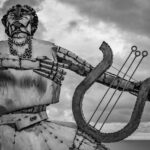Gaia: The Earth Goddess of Greek Mythology
GAIA, also known as Gaea, represents the embodiment of the Earth in Greek mythology. As one of the primordial deities, she arose from the very beginnings of creation. Often referred to as the Great Mother, Gaia was the source of all life. The heavens, the oceans, sea gods, Giants, and various mortal creatures emerged from her essence.
Gaia played a complex role in the cosmic order. Initially, she was at odds with her husband, Ouranos (the Sky), who confined many of her children within her womb. Her rebellions showcased her fierce protective instinct toward her offspring. After teaming up with Zeus against Kronos—her son who sought to imprison the Titans—she found herself in conflict with Zeus, angry over his capture of her Titan children. Gaia’s quest to retaliate led to the creation of the Giants and the monstrous Typhoeus, yet these attempts also failed to dethrone him.
In ancient Greek thought, the representation of Earth was often conceptualized as a flat disk, surrounded by the river Okeanos (Oceanus) and covered by the celestial dome of the sky, with Tartaros as a deep abyss beneath. Gaia was depicted in ancient art as a voluminous, matronly figure intertwined with the Earth, her nurturing aspect shown through lush imagery of fruits and seasonal representations.
Gaia’s Family Tree
Parentage
Gaia is considered to have emerged from the primordial state of existence, often associated with water elements such as Hydros, and sometimes associated with Aither and Hemera.
Offspring
- By Ouranos: Gaia bore the Titans (including Oceanus, Hyperion, and Cronus), the Cyclopes, and the Hecatonkheires (hundred-handed giants).
- By Pontos: She gave birth to sea gods like Nereus and Thaumas.
- Other notable offspring: Giants, lesser beings, and divine spirits including the Erinyes (Furies), and dangerous monsters like Typhoeus.
Cult and Worship
Gaia was frequently invoked in oaths and rites, recognized as a fundamental figure across various Greek city-states. She held a prominent place in temples across Greece, including major sites like Delphi and Olympia. Notable statues and altars were erected in her honor, reflecting the deep-rooted reverence of the ancient Greeks toward her as the provider of life and sustenance.
Literature and Inheritance
Gaia’s narrative is further enriched by sources such as Hesiod, who elaborates on her role in the creation and sustenance of divine beings. The Theogony highlights her interactions with other gods, such as forming alliances and facing betrayals. In the Homeric hymns, she is lauded as the “mother of all,” emphasizing her position in the pantheon.
Gaia’s Conflicts and Legacy
The tales of Gaia encompass themes of conflict and transformation. Her struggles against Ouranos, Kronos, and Zeus represent the broader cosmological battles central to Greek mythology. These narratives not only outline her progeny’s paths but reflect the connection between land, fertility, and the divine.
Ancient artwork further illustrates Gaia’s divine presence—the earth itself often depicted as nurturing yet fierce. Her legacy continues to inspire art and literature, illustrating the timeless nature of her role as a mother, creator, and challenger of destiny.
Conclusion
Gaia’s essence captures the duality of creation: nurturing and destructive, benevolent yet fierce in her resolve. As the Earth Mother, she is a foundational figure in Greek mythology, embodying the principles of life, nature, and primal strength.





